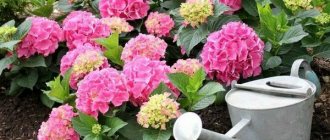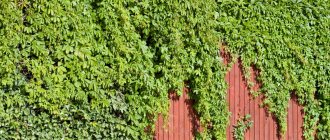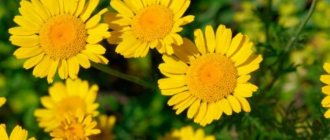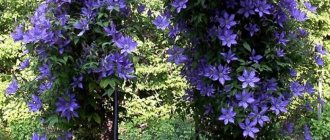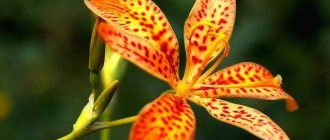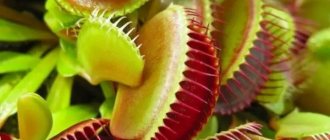Nature has endowed plants with amazing organs - leaves. Small children often depict them in the shape of hands in drawings, while adults compare them to lungs. The fact that plants also have breathing is taught to students back in school, but the fact that this process takes place in the leaves is still amazing every time, as if you are learning about it for the first time.
Everyone knows that people value greenery: just look at how many non-flowering, but green-rich indoor plants are present on the windowsills. Winter gardens and greenhouses are considered a place of rest and relaxation, so even in the most severe frosts, people who want to feel unity with nature come there with pleasure. The shapes, types and colors of foliage are so diverse that it seems as if a large-scale competition was held in which participants had to show the most daring, unusual and original ideas.
Sissy
The fern thickets look amazing: it seems that dinosaurs are about to emerge from them, hiding in the damp coolness. Indeed, ferns lived well next to these animals, providing them with shelter and food.
The green foliage that people love them for is not actually leaves in the traditional sense. In ferns, this structure is called a frond, has the same color and performs the same functions as in other plants. But there are also serious differences: it is on the fronds that fern spores develop, that is, these modified shoots simultaneously breathe and hold spores, like flowers.
But this is not even the most amazing thing about ferns. The adiantum thin-leaved species has very fragile and thin foliage. It is often used during practical classes in universities during lessons on plant anatomy, because each leaf consists of exactly one layer of photosynthetic cells. The size of these cells is quite impressive for the plant world, and under a microscope, all organelles in each cell are clearly visible. Looking at the adiantum, you can easily form an opinion about the thickness of one plant cell. The main thing is to be very careful with the fern so as not to damage the teaching aid. In nature, there are no leaves thinner than those of adiantum thin-leaved.
Calathea
This is a beautiful plant that has many varieties. Growing it requires a lot of space and careful care. It is imperative to maintain a sufficiently high air humidity.
This condition must be observed in winter, when radiators dry the air. You need to remember about regular watering. The soil in the pot should be fairly moist, but not wet.
The developer of CoviVac confirmed the possibility of revaccination with the drug
They have money and power: types of men prone to cheating in relationships
We bake a whole basket of “mushrooms”: we take a plastic bottle to help
With proper care, calathea will produce many colorful leaves with stripes, spots and other patterns. Yellow calathea also blooms beautifully.
Poisonous beauty
But not everyone in the plant world is so defenseless. There are those that look very beautiful, outshining the queen of flowers, but contact with the sap contained in their foliage can have serious consequences.
These flowers include the beautiful oleander, which is replete with amazing clusters of red, burgundy, pink or white petals that are fragrant during flowering. Looking at such beauty, it is difficult to imagine how poisonous it is: one green oleander leaf contains a dose of poison that is enough to cause the death of a person due to convulsions and respiratory arrest.
Oleander tastes bitter, so people don’t think of eating it. But the situation is different with animals: unfortunately, they often die after tasting the greens of this plant. In homes where there are small children, it is better not to grow oleander at all, so as not to put a curious child at risk.
Aglaonema
This is a very beautiful plant that is completely unpretentious. Aglaonema loves warmth and high soil moisture, which is why it requires regular watering.
This flower grows quickly and reproduces very easily. Aglaonema has several varieties with leaves of different colors, with cream, white or pink patterns. In addition, there is a variety with green-yellow leaves and a white stripe running along the edge.
Miracle or legend: Samara local historians conducted an investigation into “Zoya’s Standing”
Bob is still at the peak of fashion. Ideas for fashionable and stylish bob haircuts
Just water and a shovel: how white coral, popular in decoration, is mined
The plant should be kept in a bright place, but not in direct sunlight. However, you should be careful with the flower, as its juice is toxic.
Amazing in size
The owner of the longest foliage in the world is the raffia palm, growing in Africa, Madagascar and America. Her respiratory organs reach 25 meters in length and 3 meters in width, making her an absolute record holder. The leaf blade of this tree even exceeds the length of the trunk, which grows no more than 16 m.
Giant leaf plates have found their use among the Bapende people living in the Congo: they make unusual national costumes from raffia. A huge number of tourists come here every year to look at such “plant” outfits.
In addition, the dense substance contained in the petioles and plates is used to weave baskets, hats, rugs, and is sometimes used to make fabrics or brushes.
Leaflets from separate parts
Such beautiful maple leaves are made by folding paper, with each diamond being made separately. The workpiece has the shape of a square. It is first folded in half lengthwise. Then the upper corners are bent to the center line, and then the lower ones, to form a rhombus. You need to glue the parts with the inside down so that the folds are not visible. The parts are assembled onto a sheet of cardboard in a checkerboard pattern, connecting the corners at one point near the stem.
As you can see, there are many different ways to make paper leaves for a flower or for a picture of autumn leaf fall. Try to create your own masterpieces!
Queen
The largest water lily in the world, Victoria Amazonica, has amazing leaves up to 2 m in diameter. The plant received its name from its discoverer, the English botanist Lindley, who wished to perpetuate the name of Queen Victoria.
The leaf blade of Victoria Amazonia on the underside is covered with sharp long needles that protect the plant from being eaten by fish and aquatic animals, and the upper side is very hard, smooth and glossy. It is so dense and durable that it can easily support a weight of 30 kg, but can often support 50 kg. The record was recorded with a weight of 80 kg, that is, even the average man can swim in the Buddha position in the Amazonian Victoria.
Evaporation of moisture from the entire surface of the leaf plate does not occur, as happens in most plants. Only along the edge of the Victoria's floating circle there are numerous pores that give off excess moisture, and on the lower surface there are special structures for air, which keep the water lily afloat with decent weight, like a swimming buoy.
Anyone who has seen this amazing green island at least once will no longer be able to erase it from their memory.
Sprig of pine needles
To create carved leaves, you can also use thin strips of quilling, folding them like a large accordion. The photo below shows the step-by-step execution of such work.
First, a strip of paper is folded in half, and only then the remaining folds are made on one and the other side of the workpiece. PVA glue is applied in the center of all folds and by squeezing the side parts with your hand, a separate small branch is obtained. To create a painting, several of these elements are often made and joined together. If you need to fold a long spruce branch, then simply lengthen the workpiece by gluing one more strip to each edge.
The most modest
Mimosa pudica is a representative legume. It behaves very unusually: when you try to touch its foliage, you can see how it curls around the central veins in a couple of seconds. Botanists believe that on the leaf blades of mimosa there are special sensitive hairs that immediately trigger a chain of chemical reactions that cause cell contraction. Due to this contraction, rapid folding of the leaves occurs.
Because of this amazing feature, mimosa pudica has become a fairly famous indoor flower: it is very interesting to look at how it folds its leaves. But you need to remember that this action takes a lot of strength from the plant, so constant attempts to force it to close can completely deplete the flower and lead to its death.
Corrugated leaves
Beautiful autumn leaves from paper can be made according to the diagram below. Colored paper for crafts is double-sided. The sheet is folded in half and a truncated triangle is cut out. Then the paper unfolds again and the sheet begins to fold like an accordion.
All that remains is to fold the blank in half and glue the straight edges in the center together. If you need a stem for work, then before gluing the halves, twist a stick out of paper and, folding it in half, wrap it around the corrugated workpiece. Only then can the edges of the leaf itself be glued together. The stick twists at the bottom, connecting both halves of the stem together.
Green peas
When most people see Rowley's ragwort, they think it is an artificial plant. The fact is that its foliage is so unusual and amazing that it is difficult to believe that nature created it. Instead of plates, the respiratory organs of the godson have acquired the shape of peas, which are strung like beads on stems drooping down. Because of this appearance, Rowley's ragwort has another popular name - “threads of pearls”.
The spherical shape of the respiratory organs arose in order to accumulate a large amount of water inside, since in nature Rowley's ragus grows in the mountains of Namibia, where the climate is changeable and there are long periods of drought. In houses and apartments, there is no need for pearl threads to store moisture; here they often act as an exotic “curtain” on the windowsill or at the door.
Crochet leaves, large selection of patterns
The sheet is crocheted according to pattern 1 using both half loops:
The sheet is crocheted according to pattern 1 using the back half loop:
The texture of the sheet in the first photo turned out to be flat, in the second - ribbed.
Sheet 1 is crocheted according to pattern 2
Pattern 4. Crochet a leaf
Diagram 5 shows a sheet in which the turns are connected alternately in different directions. A variety of leaf shapes decorates the composition and gives it expressiveness. Experiment too.
How else can you get curved leaves? In addition to jagged ones, there are rounded and arbitrary leaf shapes. Often found in compositions are small leaves connected by columns of different sizes. To add rigidity and beauty, tie them with single crochets with a “picot” or “crawfish step” (see diagram 6 and 7).
leaves are crocheted according to patterns 6 and 7
Knitted clover leaves:
Knitted oak leaf
Razor grass
Putiang pampas grass grows in New Guinea. The name from the local dialect translates as “sharp stakes”, and there are obvious reasons for this: the foliage of this grass is so strong, hard and sharp, like a knife made of high-quality steel, that the Papuans have long used it during fighting and hunting.
Cuts made by putiang easily penetrate to the bone because the sheet is very thin and cuts quickly. Such wounds take a long time to heal, so the Papuans themselves avoided the thickets of this grass, and sometimes planted it around their settlements as protection from unwanted guests.
A little later, residents of the Pacific island began to use putang leaves when shaving, and they assured that such a disposable razor shave cleaner and faster than a real one.
Unusual relic
Velvichia is a flower that appeared on Earth before the era of mammals. This plant lives in the dry Namib Desert, where there is almost no rain. For this reason, Velvichia cannot afford lush foliage. She lives her whole life with 2 leaves, which appear and die with her.
Their function is to collect precious moisture contained in the morning air. The holes, which are located on the leaf plate, accumulate water and transmit it further along the veins. Her respiratory organs continue to grow slowly throughout her life (1200 - 1300 years), so their size can reach up to 6 m in order to collect as much dew as possible over a huge area. While new tissues grow at the base, the old ones at the ends gradually dry out.
In some photographs you can see that Velvichia has much more leaves than 2. This is easily explained: in order to shade the roots from the heat, the flower divides the leaf into narrow ribbons, which, twisted, reliably cover the ground from the scorching sun, helping the plant to survive .
It is also interesting that Velvichia lives its entire life at the seedling stage, so its leaf blades are large sprouted cotyledons.
Maranta
This is a beautifully colored plant. It has several varieties. The most popular are plants with white veins. The oval leaves appear to be colored in different shades of green with the addition of pink and white.
Arrowroots are quite demanding in terms of conditions. First of all, you need to ensure sufficiently high air humidity. In addition, you should take care of regular watering. Maranta loves diffused light and warmth, and the flower also requires a waterproof and fertile substrate.
The fate of Archil Gomiashvili’s daughter and son, who also became actors
Restore blood vessels after coronavirus: recommendations from a therapist
Crocuses love phosphorus: how to feed them before flowering so that they will surprise you in April
Leaves-stones
Another representative of the deserts of Namibia, South Africa and South Africa, in the process of evolution, acquired leaves that help it survive in difficult conditions. Lithops or stone plants have an aerial part formed by two thickened leaf plates fused together.
Inside they have fleshy fiber that retains the moisture and starch they need to survive. In the middle of this fused structure there is a gap from which the bud grows and the flower opens. During flowering, leaf tissue releases most of the accumulated nutrients, so by the end of flowering they can become wrinkled and dried out. As soon as the first rain falls in the desert, they replenish their reserves and again acquire the desired shape.
Thanks to the amazing structure of the leaf plates, lithops really look like small stones up to 5 cm in diameter, especially since they are not only green, but also brown or grayish in color.
Caladium bicolor
This plant has amazingly beautiful leaves. They grow on a fairly long shoot and can be pink, white, green and red. The sheets can have beautiful patterns, dots and spots.
To grow caladium, a temperature of up to 26 degrees and a bright windowsill is required. However, the plant should not be exposed to direct sunlight. The flower requires a high level of air humidity and regular watering. Do not allow the soil to dry out or flood it too much.
The most inconspicuous
Everyone has known since school biology lessons that cacti have modified organs that help them survive in hot conditions. These organs are needles that prevent excess moisture from evaporating. It was difficult for scientists to understand how spines could perform all the other functions of leaf blades. A few years ago it stopped being a secret.
The fact is that on the thick trunk of most cacti there are micro leaves that are not visible to the naked eye. Their size ranges from 30 to 2000 microns, so it was impossible to see and examine these organs with the naked eye. They went unnoticed for so long because samples for study were most often taken from the middle or upper part of the cactus, where more active growth occurs. Botanists now know that at the base of the thick stems of most cacti species there are densely arranged microleaves, which are considered to be among the smallest on Earth.
Leaves using quilling technique
Many craftsmen use thin strips when working with paper, making crafts using the quilling technique. It is not difficult to make parts of different shapes, however, so that the leaves are of the same density and size, it is more convenient to buy a ruler for quilling. There are round holes of different diameters on it. The first frame of the photo below clearly shows how to use this device.
To make it convenient to roll paper into skeins, craftsmen use a special hook with a fork at the end into which a piece of paper tape is inserted. If you are trying this type of work for the first time, you can wind paper on the rod of a paste pen.
To create beautiful paper leaves with your own hands, first twist a green strip onto a rod. Attach a yellow ribbon to its edge with PVA glue and continue winding the skein further. Attach the edge of the tape to the last turn of the PVA. Next, remove the workpiece from the ruler and press it with your fingers on both sides to give it the shape of a leaf. When several blanks are made, they can be used in any picture, for example, glued along a stem with a flower on top.
Nimble and punchy
Another amazing modified leaves that nature has provided green peas with are tendrils. These organs are capable of constant circular movements, which is clearly visible in the accelerated video. Swinging in a circular motion, the antenna waits until it collides with a support. If such contact occurs, it stops behaving so violently, and begins to quickly grow and wrap around the support. Thanks to this, the peas continue to maintain an upright position even when the trunk with fruit becomes too heavy.
In laboratory conditions, it was possible to establish that after contact, twisting begins within 1.5 - 2 minutes and continues for 48 hours. Throughout all this time, the tendril does not stop performing the functions of respiration and moisture evaporation that are natural for leaves, turning into a “universal soldier.” Thanks to this amazing metamorphosis of the leaf blade, peas can compete with many plant species and successfully bear fruit.
Amazing foliage is not limited to this list at all. There are representatives with an unusual shape, unexpected shades in coloring, or properties that are simply amazing. Some of them, with their beauty, can outshine the main decoration of the plant world - flowers. All this shows that nature is multifaceted and diverse, for which people value it.
Types of crochet leaves
There are many variations of knitted leaves. After all, their patterns are suggested to knitters by nature itself. The principles of their knitting are similar. You need different ones: openwork and dense, straight and curved, copies of real ones and fantastic ones. Let's look at the most popular:
- Clover leaves crochet - the simplest option, even beginner needlewomen can do it. Despite the simplicity of execution, this element is an interesting decoration, especially for children's clothing.
- Crocheted leaves are the basis of Irish lace. Irish knitting is considered one of the most difficult, but anyone can knit its elements.
- Ribbed crochet leaves are used for openwork motifs. They look very beautiful in lace napkins.
- Crochet maple leaves It can be part of the whole canvas, an independent napkin, stand or potholder, or it can also decorate the product.
- Trefoils are usually knitted as a base for flowers, in particular roses. They are miniature and knit quickly.
Taking any version of a classic sheet as a sample, you can change and complement it to your liking, obtaining original patterns.
Yarn and hooks for leaves
Knitting threads and hook are selected depending on the purpose of creating leaves.
- If it is a flower painting or interior decor, then most often they buy thin cotton threads “Iris” and a hook number 1.0 or 1.5.
- If you have to decorate clothes, then the yarn should be identical to the product.
- If you decide to crochet clothes in the style of Irish lace from leaves, then use linen threads or mercerized cotton.
Crocheted leaves are easy to make; moreover, it’s not difficult to use your imagination to create something of your own, original. And in flower arrangements and decor they are simply irreplaceable. Moreover, by connecting these fragments, you can create an exclusive canvas.
